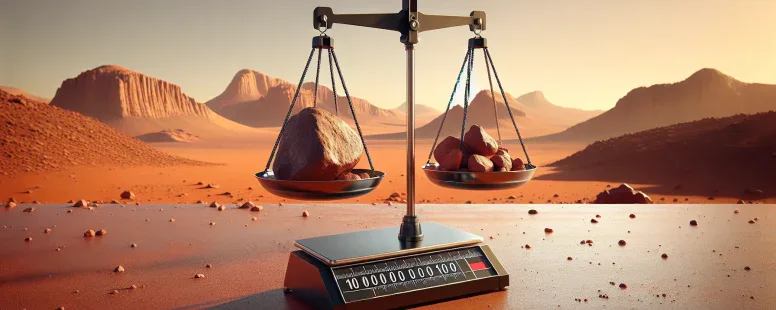True or False: An Object Has the Same Mass on Earth as It Does on Mars?
Picture holding a rock in your hand, feeling its weight pressing down against your palm. Now picture yourself standing on Mars, the red planet’s barren landscape stretching endlessly around you. Would that same rock feel lighter? While weight changes depending on where you are in the universe, does its mass remain constant?
Understanding Mass And Weight
Mass and weight, often used interchangeably, represent distinct physical properties. While mass remains constant everywhere, weight varies based on gravitational forces.
Defining Mass
Mass measures the amount of matter in an object. It doesn’t change whether you’re on Earth, Mars, or floating in space. For example, a 10-kilogram object contains the same quantity of matter regardless of location. Scientists use units like kilograms (kg) or grams (g) to quantify it.
Mass provides a universal metric for comparing objects’ substance without considering external forces like gravity. This invariant property is why astronauts can calculate their equipment’s mass even in microgravity environments.
Differentiating Mass And Weight
Weight depends on gravity acting upon an object’s mass. On Earth, gravitational acceleration averages 9.8 m/s²; on Mars, it’s approximately 3.7 m/s². An object weighing 100 pounds on Earth weighs only about 38 pounds on Mars due to weaker gravity—yet its mass stays identical.
Using scales exemplifies this difference : spring-based scales measure weight by responding to gravitational pull, while balance scales compare masses directly and remain unaffected by location shifts.
Understanding these distinctions clarifies why measurements like “mass” provide consistency across diverse planetary conditions where “weight” fluctuates with local gravity variations.
Gravitational Forces On Earth Vs. Mars
Gravitational forces differ between planets due to variations in size, mass, and density. These differences directly affect weight but not mass.
Gravity On Earth
Earth’s gravity stems from its larger mass and higher density compared to Mars. With a gravitational acceleration averaging 9.8 m/s², it exerts stronger force on objects. For example, a person weighing 150 pounds on Earth experiences this due to the planet’s pull proportional to their mass.
Earth’s relatively strong gravity influences everyday life significantly—it keeps oceans contained, maintains atmospheric layers, and supports biological functions like blood flow against gravity. But, this same strength makes lifting heavy objects more challenging than on smaller celestial bodies.
Gravity On Mars
Mars has weaker gravity because of its smaller size (53% of Earth’s diameter) and lower mass (11% of Earth’s). Its gravitational acceleration averages only 3.7 m/s²—about 38% that of Earth’s—which means objects weigh markedly less there.
For instance, if you carried a backpack weighing 50 pounds on Earth to Mars, it would weigh approximately 19 pounds under Martian conditions while retaining identical mass. This reduced weight allows for easier physical exertion but presents challenges like maintaining bone density over time during extended stays.
Mars’ weaker pull also contributes to its thin atmosphere and lack of liquid water stability on the surface—factors critical for sustaining human life without technological intervention or protective habitats.
True Or False: An Object Has The Same Mass On Earth As It Does On Mars
An object retains the same mass on both Earth and Mars. But, differences in gravitational forces affect the weight of that object.
The Concept Of Mass Consistency
Mass reflects the amount of matter in an object. It’s independent of location, whether you’re standing on Earth, Mars, or floating in space. For example, a rock with a mass of 5 kilograms (kg) contains the same quantity of matter no matter where it’s measured. Unlike weight, which depends on local gravity, mass remains constant across different environments.
If you used a balance scale to measure this object’s mass on each planet, you’d find identical results because these scales compare objects’ masses rather than relying on gravity for readings.
Impact Of Gravitational Differences On Weight
Weight changes due to variations in gravitational acceleration between planets. Earth’s average gravitational force is 9.8 m/s² compared to Mars’ weaker pull at 3.7 m/s². This means an object weighing 50 pounds (lbs) on Earth would weigh about 19 lbs on Mars while maintaining its original mass.
Consider astronauts exploring the Martian surface: tools and equipment weigh significantly less there than back home but still require the same effort to move them due to unchanged inertia linked with their mass.
Key Takeaways About Mass And Gravity
- Mass Stays Constant Everywhere
An object’s mass remains unchanged regardless of location. For example, a 15-kilogram rock on Earth retains the same amount of matter when transported to Mars, space, or any celestial body.
- Gravity Dictates Weight Differences
Weight changes with gravitational force acting on an object. Earth’s gravity (9.8 m/s²) is stronger than Mars’ gravity (3.7 m/s²). This means an object weighing 70 pounds on Earth would weigh about 27 pounds on Mars.
- Independent Nature of Mass and Weight
While weight depends on gravity, mass is a measure of matter and doesn’t vary by environment. A balance scale reflects constant mass measurements across planets, while spring scales show weight influenced by local gravity.
- Gravitational Impact Comparisons
Earth’s greater gravitational pull supports atmospheric retention and ocean stability but requires more energy for lifting objects compared to Mars’ weaker gravity that allows easier movement yet challenges sustaining life forms like humans due to bone density loss.
- Practical Implications for Space Exploration
Conclusion
Understanding the difference between mass and weight is key to grasping how objects behave across different planets. While gravity changes from Earth to Mars, an object’s mass remains constant because it represents the amount of matter in it. This distinction not only deepens your knowledge of physics but also highlights practical considerations for space exploration and living in varying gravitational environments. Recognizing these differences helps you appreciate the unique challenges posed by other worlds while reinforcing the unchanging nature of mass as a fundamental property of matter.
- GDP Versus GNP: Understanding the Key Differences - November 14, 2025
- Which Is Best: CV or Resume? Understanding the Differences - November 14, 2025
- Which Is Best: ECE or CSE? - November 14, 2025







